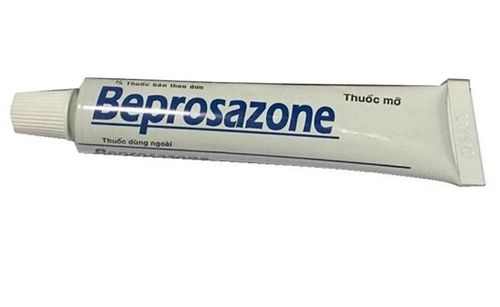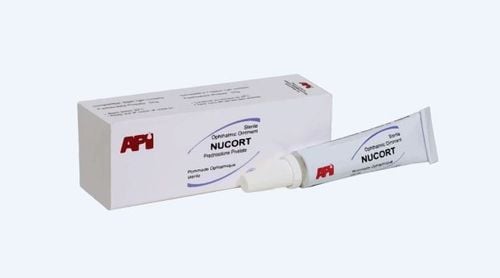This is an automatically translated article.
Axcel is a drug commonly used to treat dermatological diseases such as contact dermatitis due to irritation, dermatitis eczema, leech nests, genital itching, ... On the market today there is a lot of information. Information about the drug product Axcel however is not complete. To better understand what Axcel is, what are the uses of Axcel, let's learn more in the article below.
1. What is Axcel cream?
Axcel's main ingredient is Hydrocortisone, which belongs to the group of topical antibacterial corticosteroids. The drug is a product of Kotra Pharma Company (M) Sdn. Bhd - Malaysia, made in the form of a milky white topical cream, packed in tubes of 5g and 15g.Axcel cream is prescribed by doctors for skin treatment in the following cases: Contact dermatitis, allergic skin diseases and including insect stings, chronic eczema in lichenification stage , dermatitis (allergic eczema including eczema in children due to food and fungal dermatitis with eczema), neurodermatitis and neurodermatitis, eczematous dermatitis, coinfective eczema, eczema in hands and feet, hives, nonspecific pruritus in the genital area, cheilitis, seborrheic dermatitis and diaper rash, lichen planus.
2. What are the uses of Axcel?
2.1. Mechanism of Action Axcel Topical corticosteroids have antipruritic, anti-inflammatory and vasoconstrictor properties. The anti-inflammatory mechanism of topical corticosteroids remains unclear. However, hydrocortisone is thought to work by induction of phospholipase A2 inhibitory proteins, collectively known as lipocortin. The researchers suggest that these proteins control the biosynthesis of potent inflammatory mediators such as leukotrienes and prostaglandins by inhibiting the release of their common precursor, arachidonic acid. Arachidonic acid is released from the phospholipid membrane by the enzyme phospholipase A2.
2.2. Pharmacodynamics of the drug Axcel Absorption of the drug Axcel When using Axcel cream topically, the drug can still be absorbed systemically. Especially for long-term topical use, occluding the application area or applied to a large area or applied to open wounds, the amount of drug absorbed into the body may be enough to cause systemic effects, including inhibition of the axis. hypothalamus - pituitary - adrenal gland.
Distribution of the drug Axcel After the drug is absorbed into the body, about 90% of the drug will be bound to plasma proteins, mainly to albumin and corticosteroid-binding globulins (CBG, a type of α2 globulin synthesized in the liver. ). Only the free drug fractions are able to penetrate the target cells and cause pharmacological effects.
Metabolism and Elimination of Axcel 100 minutes is the half-life of hydrocortisone. The hydrocortisone in Axcel cream is metabolized in the liver and most tissues in the body to the hydrogenated form of tetra hydrocortisone and the breakdown of tetrahydro cortisol. These substances are then excreted in the urine, mainly as glucuronic conjugates and in small amounts unchanged. Hydrocortisone can cross the placenta.
2.3. Contraindications of the drug Axcel Patients who are allergic to any component of the topical Axcel cream Patients with fungal infections, chicken pox, skin tuberculosis, recently vaccinated, Herpes simplex infection. Axcel cream should not be used in the ear if the patient's eardrum is perforated. 2.4. Side effects when using Axcel cream During long-term glucocorticoid treatment, the most common side effects (ADRs) were osteoporosis of varying severity and pseudo-Cushing's disease state.
Common side effects:
Cardiovascular: Hypertension, mild edema Ophthalmologic: Glaucoma, cataract, Musculoskeletal: Muscle atrophy, osteoporosis, Endocrine effects: Degrees various of pseudo-Cushing's syndrome, children with growth retardation; secondary pituitary and adrenocortical unresponsiveness, especially during periods of stress, such as after trauma, surgery or illness, and excessive weight gain. Uncommon side effects:
Gastrointestinal: Bleeding ulcers, peptic ulcers, small bowel ulcers. Psychiatric: Confusion or excitement, depression when stopping taking the drug. Rare side effects:
Skin reactions: Skin atrophy, contact dermatitis, delayed scar healing. Immune system: Anaphylactic reaction with bronchospasm. Immune response, Low virulence infections caused by pathogenic “opportunistic” bacteria. 2.5. Drug Interactions There are not many clinical studies on the interaction of Axcel cream with other drugs when used concurrently. But to be safe when using it, you should tell the doctor treating you about the drugs or supplements that you are using at the moment. And also should not mix topical drugs together to avoid drug incompatibility.
2.6. Note when using Axcel cream Hydrocortisone can fade or promote infections in the early stages. If there is a possibility that you have a bacterial infection, your doctor will consider the use of additional therapies (eg, a combination antibiotic) and if the infection does not respond rapidly to therapy, it should be stopped immediately. Use Axcel cream until your infection is under control.
Undesirable effects that occur in the body may occur when using Axcel cream topically on a large scale. Note that the medicine should not be applied and then covered. Although hydrocortisone is known to be highly effective in treating the symptoms of skin diseases, it is still important to understand and treat the causes of the disease if possible.
Drugs that cross the placenta should be limited to long-term and large-scale use in pregnant women. Systemic use of hydrocortisone is present in breast milk and may inhibit growth, interfere with endogenous corticosteroid production, or cause other undesirable effects. The safety and effectiveness of Axcel cream in pediatric patients under 3 months of age have not been established. Do not take the medicine for longer than 4 weeks. If you don't see improvement within 2 weeks, contact your doctor. Avoid contact with eyes. Do not use Axcel cream on your face, armpits, or groin unless directed by your doctor. Do not use Axcel cream on the diaper area, as diapers or diapers act like a wound dressing. Do not use other corticosteroid-containing products while using Axcel cream without consulting your doctor first. Patients applying topical corticosteroids over large surface areas or areas of obstruction should be considered for periodic evaluation of the HPA axis. Performed using the cosyntropin stimulation test (ACTH 1-24) (CST). If HPA axis suppression is noted, the frequency of administration should be reduced or the drug withdrawn or a less potent corticosteroid substituted. Symptoms and signs of glucocorticosteroid depletion may occur, requiring additional systemic corticosteroids. Minimize systemic corticosteroid effects by minimizing risk factors for increased systemic absorption and using Axcel cream as recommended.
3. How to use Axcel urea effectively?
Apply a thin layer to affected skin 2 or 3 times daily for corticosteroid-responsive dermatosis in adults and massage gently.
Apply a thin layer to atopic dermatitis twice daily for patients 3 months of age and older and massage gently. The safety of Axcel cream in pediatric patients has not been established after 4 weeks of use. Discontinue Axcel cream when control is achieved.
Do not use the drug for more than 2 weeks. When the disease is cured, the drug should be stopped. If there is no response after 2 weeks of treatment, the drug should be discontinued and the diagnosis reviewed.
Please dial HOTLINE for more information or register for an appointment HERE. Download MyVinmec app to make appointments faster and to manage your bookings easily.













